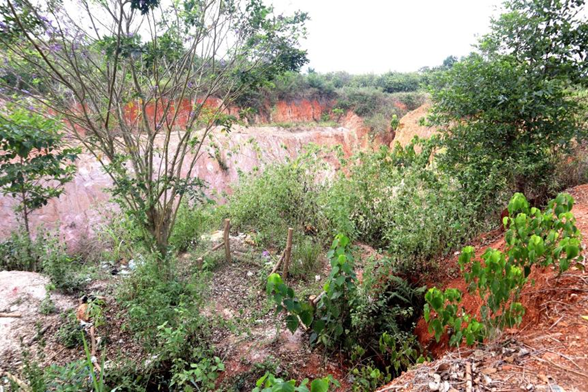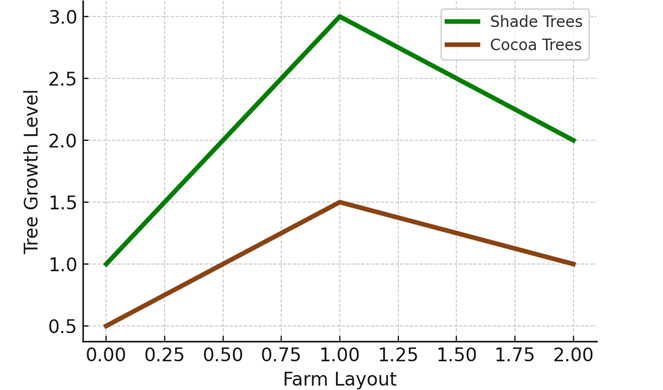By Harriet Frimpong. February, 2025.
Introduction
Ghana is the world’s second-largest producer of cocoa, a crop that supports the livelihoods of over 800,000 farmers and contributes significantly to the country’s economy. Cocoa exports account for about 19% of Ghana’s total export earnings (Ghana Cocoa Board, 2023). However, climate change poses a significant threat to this industry. Rising temperatures, unpredictable rainfall, and deforestation are affecting cocoa yields, putting farmers’ incomes at risk. Climate-smart cocoa farming offers a sustainable solution to ensure long-term productivity and resilience.
Understanding Climate-Smart Cocoa Farming
Climate-smart cocoa farming involves sustainable agricultural practices that enhance productivity while reducing environmental impact. These methods help farmers adapt to climate change and improve their livelihoods. According to the World Cocoa Foundation, implementing climate-smart techniques can increase yields by up to 30% while reducing greenhouse gas emissions by 25%.
Field Visit to Mpasatia, Ashanti Region

- Illegal Mining (Galamsey) Impact: Rampant illegal mining activities in the region severely impact cocoa farming. The chemicals and dynamite used in mining pose a heat threat to the roots of cocoa plants, affecting their growth and long-term survival.
- Water Scarcity: Farmers face serious water shortages, making it difficult to maintain healthy crops, especially during dry seasons.
- Soil Degradation: Continuous land use without proper soil management depletes essential nutrients, reducing cocoa yields over time.
- Deforestation: The clearing of trees for mining and other activities reduces the availability of shade, leading to increased temperatures that stress cocoa plants.
- Pest and Disease Outbreaks: Farmers struggle with pest infestations and plant diseases, which lower productivity and require integrated pest management strategies.


Ethical Climate-Smart Cocoa Farmers: Agya Atta & Isak
Despite these challenges, two ethical climate-smart farmers, Agya Atta and Isak, stood out for their commitment to sustainable farming practices. Their methods focus on preserving the environment while ensuring high yields.
Key Climate-Smart Practices They Implement:
- Organic Mulching: They spread dry leaves and dead cocoa shells on the soil surface to retain moisture and protect the roots from excessive heat.
- Zero Burning Approach: Instead of burning rotten cocoa shells, they repurpose them to make soap, reducing waste and promoting environmental sustainability.
- Agroforestry: They have planted shade trees among cocoa plants, reducing soil erosion and protecting cocoa trees from excessive sun exposure.
- Soil Nutrient Conservation: They use compost and organic fertilizers to enrich the soil, avoiding chemical overuse.
- Efficient Water Management: Collecting and utilizing rainwater to combat water scarcity during dry periods.
FIG. 1. ILLUSTRATION SHOWING THE BENEFITS OF AGROFORESTRY IN COCOA FARMS

This diagram illustrates the agroforestry approach, where cocoa trees are planted alongside shade trees to help regulate temperature, improve soil fertility, and enhance biodiversity. Studies have shown that agroforestry can reduce soil temperatures by up to 5°C, making farms more resilient to climate change.
The Role of Technology and Education in Climate-Smart Cocoa Farming
Technology and education are crucial in driving climate-smart cocoa farming. Digital platforms such as the CocoaLink mobile app provide real-time farming advice, weather forecasts, and market prices, helping farmers make informed decisions. Additionally, farmer field schools supported by the Ghana Cocoa Board have trained over 200,000 cocoa farmers in climate-resilient techniques.
However, Agya Atta and Isak have not directly benefited from these initiatives. While they are aware of such programs, they have not received direct support or training because no personnel have been dedicated to implementing these initiatives in their community. This highlights a gap in outreach and accessibility, emphasizing the need for decentralized support structures to ensure that all farmers, regardless of location, can benefit from climate-smart education and resources.
Climate Change Challenges and Government Initiatives
- Impact of Climate Change: Ghana’s cocoa-growing regions have experienced a 0.8°C increase in average temperatures over the past 30 years, leading to reduced yields and increased vulnerability to pests (Climate Change Impact Report, 2023).
- Government Response: The Ghana Cocoa Board, in partnership with international organizations, has launched initiatives such as the Climate-Smart Cocoa Programme, which aims to reforest degraded farms and introduce drought-resistant cocoa varieties.
However as previously noted, there remains a gap in outreach and accessibilty.
Lessons and Recommendations
The visit to Mpasatia highlights the urgent need for more education, policy interventions, and investment in climate-smart cocoa farming. Recommendations include:
Strengthening Regulations on Illegal Mining to protect farmlands.
Promoting Agroforestry to maintain biodiversity and soil fertility.
Providing Irrigation Solutions to help farmers cope with water shortages.
Encouraging Innovation like Agya Atta and Isak’s methods to maximize sustainability.
Enhancing Farmer Training Programs with a focus on reaching underserved communities.
Conclusion
Climate-smart cocoa farming is not only essential for ensuring long-term sustainability but also for protecting Ghana’s position as a leading cocoa producer. The resilience and innovation demonstrated by farmers like Agya Atta and Isak serve as an inspiration for others. Through education, policy support, and community-driven initiatives, Ghana’s cocoa sector can thrive while preserving the environment.


References:
Asare, R., & Ræbild, A. (2016). Tree diversity and canopy cover in cocoa agroforests in Ghana. Agriculture, Ecosystems & Environment, 217, 1-10.
Climate Change Impact Report (2023). Effects of Climate Change on Cocoa Farming in Ghana.
Ghana Cocoa Board (2023). Cocoa Industry Statistics and Reports.
Ghana Cocoa Research Institute (2023). Pest and Disease Control in Cocoa Farming.
International Institute of Tropical Agriculture (2022). Soil Conservation in Cocoa Farming.
Läderach, P., Martinez-Valle, A., Schroth, G., & Castro, N. (2013). Predicting the future climatic suitability for cocoa farming of the world’s leading producer countries, Ghana and Côte d’Ivoire. Climatic Change, 119(3-4), 841-854. World Cocoa Foundation (2022). Sustainable Cocoa Farming Strategies.

Leave a Reply